Bodhipaksa's Blog, page 68
November 7, 2012
Practice mindfulness: don’t become roadkill on the information superhighway
 I just stumbled across a lovely column by author Pico Iyer in the New York Times on “The Joy of Quiet.”
I just stumbled across a lovely column by author Pico Iyer in the New York Times on “The Joy of Quiet.”
He discusses how overwhelmed we are:
In barely one generation we’ve moved from exulting in the time-saving devices that have so expanded our lives to trying to get away from them — often in order to make more time. The more ways we have to connect, the more many of us seem desperate to unplug.
I tend to think of us — well, most of us, anyway — as being a bit like early 20th century rubes from the sticks who have just arrived on Times Square, and are dazzled by the displays to the point where we’re a danger to ourselves and others.
I also think this is a transitory phase, and that the tide, in some ways, is beginning to turn. Perhaps that’s not the best metaphor, because while the tide can only go in one direction at any given time, in some respects I think things in the realm of attention and distraction will go in both directions at the same time; you’ll see more people trying to do more multitasking at the same time as you get more people finding ways to withdraw and find an accommodation with the deluge.
Perhaps it’s going to be like the realm of health and fitness, where you see both an explosion of obesity and a rising interest in gyms.
That means that ardent multitaskers may be the informational equivalent of nacho-gorging couch potatoes, while those with a keener sense of the worth of their attention (and the need to preserve it) are more like healthy-eating exercisers. Because multitasking doesn’t really get stuff done, and it has a bad effect on our minds.
I suspect that at some point obesity rates are going to drop, because one way or another they have to. Policies will be put in place or some pill will be found that helps people to keep the pounds off. I don’t think there’s likely to be a pill that helps us develop mindfulness, but there too I think there will be a cultural push to encourage more reflection and down-time. And for the same reason — we’ll have to. I think we’ll have to because people with fragmented minds are incapable of processing information effectively. I’ve seen this in high school students; words just wash over many of them, and if you ask them to restate something they’ve just read they’ll often just tell you something they already know (whether or not it’s relevant to the reading they’ve done) because no learning has taken place. No civilization can survive, no business can thrive, based on minds that are incapable of learning. So that’s why I think things will change.
 Here are some signs that I see of the change happening.
Here are some signs that I see of the change happening.
Iyer mentions some in his column:
“…those who part with $2,285 a night to stay in a cliff-top room at the Post Ranch Inn in Big Sur pay partly for the privilege of not having a TV in their rooms; the future of travel, I’m reliably told, lies in ‘black-hole resorts,’ which charge high prices precisely because you can’t get online in their rooms.”
The wealthy are either the first to realize that they need to protect their attention, or at least have found the most ostentatious way of doing so.
“Writer friends of mine pay good money to get the Freedom software that enables them to disable (for up to eight hours) the very Internet connections that seemed so emancipating not long ago.”
And there are less expensive ways to achieve similar ends. Some people, myself included, use full-screen writing software, some of which is free, like the WordPress software I’m writing on now, which has a full-screen mode. Some people are disciplined enough to turn off their email programs and other alerts in order to avoid interruption.
“Intel (of all companies) experimented in 2007 with conferring four uninterrupted hours of quiet time every Tuesday morning on 300 engineers and managers. (The average office worker today, researchers have found, enjoys no more than three minutes at a time at his or her desk without interruption.) During this period the workers were not allowed to use the phone or send e-mail, but simply had the chance to clear their heads and to hear themselves think. A majority of Intel’s trial group recommended that the policy be extended to others.”
I think businesses are increasingly going to recognize that attention is a resource that needs renewal. Those that don’t will fail.

Visit our online meditation supplies store for books, CDs, MP3s, and everything else you need to get you started with meditation.
A recent article, Multitasking loses its cool; Mindfulness is now in, points out that “Mindfulness training can help people focus, see clearly, work with change, form deeper relationships and more.”Another points out that mindfulness makes you a better leader:
The practice of mindful leadership gives you tools to measure and manage your life as you’re living it. It teaches you to pay attention to the present moment, recognizing your feelings and emotions and keeping them under control, especially when faced with highly stressful situations. When you are mindful, you’re aware of your presence and the ways you impact other people. You’re able to both observe and participate in each moment, while recognizing the implications of your actions for the longer term. And that prevents you from slipping into a life that pulls you away from your values.
Google is teaching mindfulness to its employees. So is General Mills. And Plantronics.
And talking of Google, the forthcoming Google Glass project — sci-fi style head-up display glasses — are designed not to get in between you and your experience of the world. It’s hard, initially, to see how they are pulling this off, but that’s what have said it manages to achieve.
Technology can help us avoid overload, but fundamentally it’s we ourselves that will determine whether technology is our tool or whether we are a tool of technology. As Iyer puts it,
All the data in the world cannot teach us how to sift through data; images don’t show us how to process images. The only way to do justice to our onscreen lives is by summoning exactly the emotional and moral clarity that can’t be found on any screen.
And so he sees more of his friends turning to yoga, or meditation, or tai chi. I suspect that those who don’t are going to end up as roadkill on the information superhighway — too dazzled by the bright lights of the rectangular screens into which they stare all day to be able to achieve much, and hence unable to survive.
Todd Henry argues that we’re losing the capacity to be bored, and therefore the capacity to be creative.
So I’d say “Meditate: your future may depend on it.”
November 6, 2012
The demon in the dark
 I had a nightmare the other night. That’s unusual for me.
I had a nightmare the other night. That’s unusual for me.
True, there was the one last week where I had a bad dream that the wrong guy won the presidential election, and I awoke in a panic that the economy was about to go down the tubes again. But it’s not hard to see why I had that particular nightmare, and I’m sure I wasn’t alone in it.
The one I had two nights ago — just a little too late for Hallowe’en — was different. Much darker. And even scarier.
In this dream I’d just woken up. It was still night. I was lying in a small, dark room, alone, in a twin bed against the wall. To the left was a window, which admitted just enough light for me to be able to make out a bedside table on which sat a lamp. The corner of the room at the foot of the bed was pitch dark, although I knew that there was a door there. But there was something else in the corner as well.
I knew, the moment I “awoke” that there was some evil entity lurking in the dark shadow by the door. I was terrified of this thing, whatever it was, but I wanted to face it, to see what it was. So I reached out an arm to switch on the light, but the switch must have been faulty, or the bulb dead, and the switch clicked uselessly. I found my iPhone, and opened a flashlight app that works by using the built-in LED flash. The app opened, but the screen became unresponsive to my touch and I was unable to turn on the light.
The evil entity still lurked at the foot of the bed, in the darkness by the door.
My terror mounted, and at that point I woke up. Or I should say that I “woke up,” because I was still dreaming. Now I was in my own bed, still asleep, but thinking I was awake. And I realized that this was not the first time I’d met this entity. It had in fact been a part of my life for decades. I had flashbacks to previous encounters with it. And the really terrifying thing was that I’d forgotten every single one of them. This demonic presence had the power to induce forgetfulness, so that I could face it over and over again, and each time was like the first.
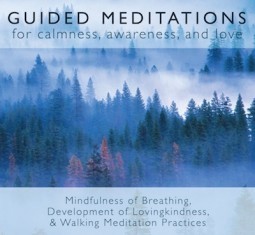
If you like Bodhipaksa’s articles, check out his books, guided meditation CDs, and MP3s.
The knowledge that I had been manipulated in this way by an evil force for basically my entire adult life was unbearable, and unspeakably frightening. How can we be so unaware? Are we really just the playthings of demons? Are our minds not our own?Then I woke up again, but for real this time. I was still terrified, and it was hard to untangle myself from the idea that I’d been manipulated my entire life by a demonic entity. And in fact I remembered (for real) that in my early 30s I had a number of nightmares involving demons, not so different from the dream of two nights ago.
It’s hard to know what to do with a dream like this. It’s still with me, and I’m troubled by it. I’m writing about it as a way of helping me deal with it.
I think it’s good that my first instinct was to turn to face the demon. That, I expect, is the result of my practice. But although I wanted to see into the darkness, I couldn’t. Perhaps I should have taken a different approach. Instead of trying to shine a light into the darkness I should have simply looked into it, or talked to whatever was in there. Perhaps shining a light on it was too invasive. Perhaps we need to treat that which we fear with respect. These are questions that I’ll be working with in my meditation practice.
One thing I’m pretty sure of is that whatever was in the darkness wasn’t evil at all. It was simply something I’m afraid of. What we’re most afraid of we often paint as evil, because that justifies our fear. I suspect that what was in the darkness was a spiritual experience — possibly terrifying, but also beautiful and good. And on the other side of that experience was a door. And on the other side of the door was … what? That’s something I hope to find out.
November 2, 2012
Two opportunities to learn meditation with Bodhipaksa
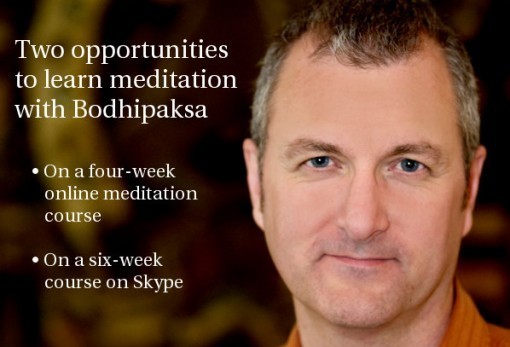
I’m pleased to offering two different ways to learn meditation. Both of these are ideal for people who have trouble making it along to a meditation center because they work evenings, don’t have a center located near them, or can’t get out of the house easily.
1. Four-Week Online Course
Since 2002, Wildmind has been offering online courses in meditation. In recent years these have been taught by Sunada, but this month I’m stepping back in to online teaching with a brand-new course called The Power of Mindfulness.
How does this work? Well, you’ll be given a username and password that gets you in to a special website.
Once you’re there, you’ll find online readings to give you background information and something to think about.
There are MP3 meditations that you can download to your iPod or phone and be guided through a variety of approaches to meditation (these are all recorded specially for this course).
There’s a discussion forum so that you can ask questions and discuss your practice with your classmates.
And you can email me every week and tell me what’s going on in your meditation practice, and I’ll write back with questions, personal guidance, and encouragement.
The beauty of this type of course is that it’s there where and when you want to be, 24/7. On the road and never in the same town two nights running? No problem. Work odd hours and find that the best time for you to learn is at midnight? Again, no problem. The course materials are always there for you.
What will you learn? You’ll learn what mindfulness is and what its benefits are for your physical, mental, and spiritual health. You’ll learn a number of approaches to meditation. And you’ll learn to take your mindfulness practice into daily life so that everything you do helps you be more centered, calm, and happy.
Click here to find out more about The Power of Mindfulness.
2. Six Week Course on Skype
The big difference here is that this course happens at a specific time. It’s 2:00 to 3:30 PM on Thursdays, starting November 8. That’s US Eastern Time. If you want to know when that is for you, visit this site and convert from USA – New Hampshire – Concord to your local timezone.
This course uses multi-party videoconferencing, so you’ll be able to see and talk with the other people in the class. The numbers are limited to around eight people, for technical reasons.
Each week, we’ll spend a little time getting to know each other. I’ll talk a bit about the practice we’re going to do, and then I’ll lead the class through a guided meditation. At the end there will be time for questions and discussion.
Everyone in the class will get a recording of each session every week, so that you can review the material and listen to the guided meditation again.
We’ll be exploring four meditation practices, including the Body Scan, Mindfulness of Breathing, Development of Lovingkindness, and Just Sitting.
Click here to learn more about the meditation class on Skype.
I love teaching meditation. It’s my passion. I love seeing people become happier and more fulfilled as they learn how to move more gracefully through life’s challenges. I do hope you’ll be able to join me in one of these course offerings.
November 1, 2012
Becoming a rock-solid regular meditator: an update
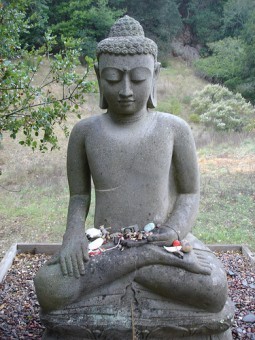
Photo courtesy of EverydayBalance
Six weeks ago I wrote a post about an attempt I was making to make my meditation practice into a “without fail” daily practice. I’ve tended to skip days here and there, and really wanted to become a rock-solid regular meditator.The particular approach I was taking hinged on the key element of self-definition. We all carry views about ourselves. These views are often not consciously articulated, but they run very deep and shape our thoughts, our emotions, and our actions.
What I decided to do was to consciously take on the task of redefining myself as a daily (no exceptions!) meditator, by repeating to myself phrases like “I meditate every day. It’s just what I do. It’s who I am.”
The results have been good! With one slip-up (I’ll come to that later) I’ve meditated every day for over two months. I’ve averaged 40 minutes of meditation a day. Some days I’ve managed to meditate twice. My “standard” meditation is 40 minutes, but on a couple of days I’ve only managed 30 minutes and on a couple of very busy days I’ve only managed 15. (Pedantry alert: A couple means “two” by the way. I’m puzzled by how many people think that “a couple” is “a few.” Think of “the happy couple” getting married — that’s two people, not three or four! End pedantry alert)
So it’s gone well. There’s just been that one day that didn’t work out. What’s that about?
Well, dear reader, I forgot! I’d been reciting my affirmation several times a day, sometimes at the start or end of meditation, or when I was lying in bed, but basically whenever the thought popped into my head. Then I was meditating absolutely every day, and after two months or so of this i started to repeat the affirmation less and less often. I guess I thought that I was doing it, so I didn’t need to tell myself to do it. This wasn’t a conscious choice — it just happened. But it turns out that this was a mistake.
Last Saturday I had a crazy busy day where I was looking after the children from first thing in the morning until getting them to bed, with about 90 minutes off during the day, in which space of time I had to get ready for a halloween costume party that I was taking the kids to. I could have meditated during that time, but I was focused on trying to get a work project ready and getting my costume ready (I went as a zombie). And I forgot. I could have meditated after the kids were in bed, but again I forgot.
So there’s a lesson here. I need my “mantra”!

If you like Bodhipaksa’s writings, and want to support this site, check out his guided meditation CDs and MP3s.
Another lesson is not to let a failure to achieve “perfection” become an excuse to give up. It wasn’t until I woke up the next morning that I realized I hadn’t meditated the previous day. And to be honest I felt a bit sick, and very disappointed. After all, there was no way to go back in time; no way to restore my track record to its 100% success rate. And a part of me thought, “That’s it, you’ve blown it,” but I decided not to take that voice, or the disappointment, seriously. I fell off the horse; it’s time to get back on. My failure to remember to meditate is just a reminder: I need my mantra! So I’m back to reminding myself, daily: “I meditate every day. It’s just what I do. It’s who I am.”Despite this minor failure, so far this has been, I think, a very successful way of developing an unshakable habit of meditating daily.
I’m obviously not quite there yet, but it seems obvious I’m making progress. Now I’ve had longer periods of meditating without missing a day, but I don’t think those experiences changed my self-view. I think I saw myself as someone who happened to be having a run of “good luck” with his meditation practice. I don’t think that fundamentally I saw myself as “a person who meditates every day.” And that’s who I want to be.
Because the benefits have been very tangible. I feel happier with myself, having a “no days off” regular meditation practice. And the effects of meditating daily have been excellent. I’m just happier, and at times almost immune from stress, even under very challenging circumstances. It’s almost as if the effects of meditating daily are cumulative, in a way that they’re not when I have days off. So I’m going to keep going with my experiment. Hopefully one day I really will see myself, on a deep level, as someone who meditates, without fail, every day, and I really will be able to let go of that mantra. I won’t need to tell myself I’m a person who meditates every day without fail, because I’ll be that person.
October 29, 2012
Introducing “The Power of Mindfulness”
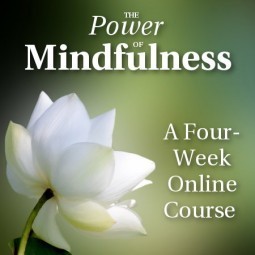 Mindfulness is an incredibly powerful practice that has been shown to have many physical and psychological benefits. How powerful is it?
Mindfulness is an incredibly powerful practice that has been shown to have many physical and psychological benefits. How powerful is it?
Amongst many other things mindfulness:
Reduces feelings of isolation in older adults
Rewires the brain, leading to better concentration and more objective self-evaluations
Reduces the severity and duration of acute respiratory infections
Reduces stress during multitasking
Boosts creative thinking
Helps with weight-loss (even if you’re not dieting
Produces a greater reduction in pain than even morphine or other pain-relieving drugs
Lowers blood pressure
Helps lower blood sugar
Boosts the immune system
Shifts activity in the brain from regions associated with stress to those associated with well-being, resulting in increased happiness.
This is quite a remarkable collection of benefits from what is, in essence, quite a simple practice!
In a new four-week online interactive course I’m going to be teaching the skills of living mindfully in a course called, appropriately enough, The Power of Mindfulness.
We’ll spend the first week deepening our mindfulness of the body through the practice of the Body Scan meditation. In the second and third week’s we’ll learn to still the mind through the practice of mindful breathing. And in the final week we’ll take our practice into the world with walking meditation, as well as a host of other ways to turn ordinary activities into vehicles to deepen and enrich our lives.
Every week there are guided meditation MP3s to download, readings to explain the background, and a discussion forum in which you can share the process of learning with fellow students from all over the world. Plus, you get the benefit of personal meditation coaching through an email exchange with me.
If you’re interested in joining me to explore The Power of Mindfulness, click here.
October 22, 2012
No expectations
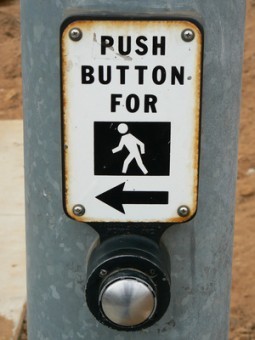 In practicing mindfulness in daily life, it’s worth watching out for small experiences that lead to tension, stress, or anger.
In practicing mindfulness in daily life, it’s worth watching out for small experiences that lead to tension, stress, or anger.
I noticed several months ago that I’d start feeling resentful as I walked toward a pedestrian crossing with the intention, of course, of crossing the road. The resentment is connected with the number of drivers who don’t stop when they see someone — well, me! — about to cross the road.
But I’d actually start getting resentful before I even reached the side of the road, long before drivers could possibly realize that it was my intention to cross in front of them. It’s all rather irrational, and goes way back, but I won’t bore you with the history.
What’s important is that I recognized that this was a source of suffering for me. It wasn’t one of these things that ruined my day, but it created an unpleasant experience that would color at least part of my day.
And it’s completely unnecessary. I was pushing my own stress buttons.
So I got into the habit of saying to myself, as I walked along the sidewalk toward the crossing, “No expectations.” It was just a little reminder that I couldn’t expect drivers to psychically know that it was my intention to cross, and that even once it should be clear that that was my intention, it was pointless having expectations that they would stop. After all, we all have times when we’re a little distracted and don’t respond promptly to things around us. What’s the point of taking these things personally?
The interesting thing is that saying “no expectations” has not just prevented frustration, tension, and anger from arising — when I say those words I find myself relaxing more deeply and enjoying my present-moment experience.
It’s a small thing, but then our lives are made out of the small things.
To apply this approach, we first have to notice that we’re causing ourselves frustration. Noticing this isn’t necessarily easy to do if our habits are longstanding. And in any event, we often tend to think of these petty frustrations as just a normal part of our experience.
And we often externalize our feelings, by which I mean that we blame the outside world for what we’re feeling. We might see it as those drivers are the problem and they’re making me frustrated rather than it’s my frustration toward those drivers that’s the problem. So we have to remember that people do not push our buttons. Our buttons are inside our heads, and we do our own button-pushing.
I can think of other circumstances in which this could be useful for me. When I log in to Wildmind’s Facebook page, for example, I often feel some disappointment when I see that an article we’ve posted a link to has received a small number of “likes.” The link to the article may have been viewed by 2,000 people (Facebook helpfully displays this information) and perhaps only 12 have clicked “like.” Now there’s a side to this where I can perhaps learn to craft better Facebook posts or to find the best times of day to post, but as long as I cling to expectations, I’m going to suffer.
I wonder what circumstances the mantra of “no expectations” could help you in your life?
Breathe easy to combat anxiety: The mind tricks that can alleviate symptoms
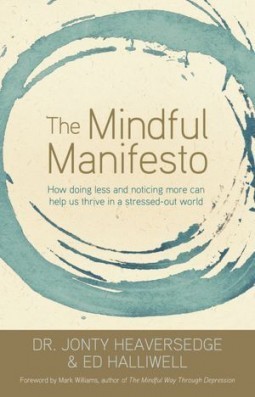
The Mindful Manifesto, by Dr Jonty Heaversedge and Ed Halliwell: available at Amazon.com and Amazon.co.uk.
More than 870,000 Britons suffer from anxiety, a condition that triggers unnecessary feelings of uneasiness and worry.Increasingly, mindfulness – a psychological therapy with roots in Buddhist meditation – is being used by the NHS to help alleviate the symptoms.
Here, in the final extract from his book The Mindful Manifesto, co-written with Ed Halliwell, Dr Jonty Heaversedge explains how it can help.
Before directing your mind towards the anxiety you are experiencing, focus on your breathing – the sensation of air slowly flowing into your nostrils, streaming down the back of your throat and into your lungs. Feel the beating of your heart and imagine how it pumps oxygenated blood around your body. Continue until you’re ready to meditate.
Now, shift your attention to your anxious thoughts. What thoughts are present in your mind right now? Are there many moving quickly or does each one remain for a while? Consider the thoughts objectively rather than reacting to them emotionally.
There’s a myth that when you meditate, you should have a blank mind. But thoughts are not the enemy and trying to stop them will only lead to more struggle. Treat the thoughts during meditation like having a radio on in the background – you can hear it, but your main focus is elsewhere. In mindfulness, you’re paying attention to the fact that you have a thought but you are not buying into what it is saying. Try not to judge the thought as ‘good’ or ‘bad’. Cultivate an attitude of equanimity to whatever goes through your mind. Watch your thoughts with curiosity and kindness and they will become easier to bear.
Whenever you notice your mind is wandering, acknowledge that it has meandered and gently bring your attention back to observing your thoughts.
Continue working with your worries in this way for the period of time you have chosen. Working mindfully can be challenging, so it’s good to practise for short periods at first.
You may feel dizzy when you start but that’s because you’ve suddenly stopped spinning around in circles. In the stillness of meditation, it can also seem as if you have more thoughts than usual but this is not so: it is just that you are becoming more aware of them. The more you practise, the more your mind can deal with worries in a less panicked way.
October 15, 2012
Business Insight: To lead, don’t be afraid to pause
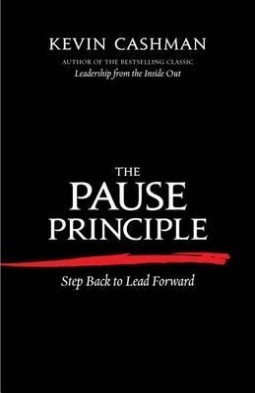
Available from Amazon.com and Amazon.co.uk.
Dawn House, The Salt Lake Tribune: Kevin Cashman, a business coach and author of “The Pause Principle: Step Back to Lead Forward,” says economic and personal crashes can be tied to addiction for constant action.Why is it important to step back?
In our 24/7 globally connected culture with a deluge of information and so much coming at us at once, the loss of pause potential is epidemic.
If leaders do not step back to stop momentum, gain perspective, to transcend the immediacies of life and to accelerate their leadership, we will continue to crash economically, personally and collectively.
Pause is the antidote to …
October 13, 2012
Mindfulness of hunger
 We all know about mindful eating: Don’t do anything else, like reading or watching TV. Take your time, really experience the sensations of lifting food to your mouth, putting it inside, chewing, swallowing. Notice the thoughts and feelings you have.
We all know about mindful eating: Don’t do anything else, like reading or watching TV. Take your time, really experience the sensations of lifting food to your mouth, putting it inside, chewing, swallowing. Notice the thoughts and feelings you have.
I have to confess I don’t do it very often. Last week I only really ate mindfully twice, and that’s because we undertook to eat mindfully at least twice as part of a meditation class. And it was actually quite hard to restrain myself from reading while eating. It’s quite a powerful habit!
But an interesting thing I’ve been doing over the last couple of weeks is being mindful of hunger.
I’ve noticed some things.
I find it easier to practice mindfulness of hunger than mindfulness of eating — perhaps because mindfulness of hunger is a new thing?
Sometimes when I think I’m hungry, I’m not. It’s just craving.
Television is a trigger for fake hunger. (I don’t actually have a TV, but I watch shows on Netflix on my laptop.) In particular, the theme tunes of TV programs induce craving — that desire to rush to the fridge to see if there’s something I can snack on.
If I simply pay attention to this craving, it’s manageable, and I can resist eating unnecessarily.
When it’s real hunger, I can mindfully pay attention to the sensations in the body.
When I’m mindful of my hunger, the sensations change. It’s less localized in the stomach and becomes a more general sensation throughout the abdomen.
When I feel real hunger, I tell myself, “This is how my body feels when it’s losing weight.” This also helps change the feeling-tone of the hunger. It ceases to be an unpleasant sensation. It’s just a sensation.
When I’m mindful of hunger, I don’t feel that I have to jump up immediately and eat something. It stops being a signal that something is “wrong” and needs immediate attention. It’s a bit more like the fuel gauge on a car pointing to 1/4 full — it’s a sign that I’m going to have to find fuel soon, but not necessarily right now. When I’m mindful of hunger in this way, I can comfortably be with the hunger for an hour or so.
I’ve lost about 4 pounds (1.8 kg) in the last couple of weeks.
His Holiness the Karmapa: The technology of the heart
The name “Karmapa” means “the one who carries out Buddha-activity,” and for seventeen lifetimes, a karmapa has embodied the teachings of Buddha in tibet. The 17th Gyalwang Karmapa, Ogyen Trinley Dorje, was born a nomad in Tibet in 1985 and recognized by the Dalai Lama in 1992 as the 17th Karmapa. The young boy was brought to the Tsurphu monastery to live and study for his life as a spiritual teacher and activist.
At age 14, he made a daring flight from Tibet, and now works from a temporary camp in Dharamsala, near his friend the Dalai Lama. (After the Dalai Lama, he’s seen as Tibetan Buddhism’s second-highest-ranking spiritual leader, though the two men lead different schools within the faith.) In 2008, he made a long visit to the United States, where he spoke and taught at Buddhist centers around the country. And in 2009 he toured Europe, speaking about faith — but also about protecting the environment.
Translator: The way I feel right now is that all of the other speakers have said exactly what I wanted to say. (Laughter) And it seems that the only thing left for me to say is to thank you all for your kindness.
Translator: But maybe in the spirit of appreciating the kindness of you all, I could share with you a little story about myself.
Translator: From the time I was very young, onward, I was given a lot of different responsibilities, and it always seemed to me, when I was young, that everything was laid out before me. All of the plans for me were already made. I was given the clothes that I needed to wear and told where I needed to be, given these very precious and holy looking robes to wear, with the understanding that it was something sacred or important.
Translator: But before that kind of formal lifestyle happened for me, I was living in eastern Tibet with my family. And when I was seven years old, all of a sudden, a search party arrived at my home. They were looking the next Karmapa, and I noticed they were talking to my mom and dad, and the news came to me that they were telling me that I was the Karmapa. And these days, people ask me a lot, how did that feel. How did that feel when they came and whisked you away, and your lifestyle completely changed? And what I mostly say is that, at that time, it was a pretty interesting idea to me. I thought that things would be pretty fun and there would be more things to play with.
(Laughter)
Translator: But it didn’t turn out to be so fun and entertaining, as I thought it would have been. I was placed in a pretty strictly controlled environment. And immediately, a lot of different responsibilities, in terms of my education and so forth, were heaped upon me. I was separated, largely, from my family, including my mother and father. I didn’t have have many personal friends to spend time with, but I was expected to perform these prescribed duties. So it turned out that my fantasy about an entertaining life of being the Karmapa wasn’t going to come true. It more felt to be the case to me that I was being treated like a statue, and I was to sit in one place like a statue would.
Translator: Nevertheless, I felt that, even though I’ve been separated from my loved ones — and, of course, now I’m even further away. When I was 14, I escaped from Tibet and became even further removed from my mother and father, my relatives, my friends and my homeland. But nevertheless, there’s no real sense of separation from me in my heart, in terms of the love that I feel for these people. I feel, still, a very strong connection of love for all of these people and for the land.
Translator: And I still do get to keep in touch with my mother and father, albeit infrequently. I talk to my mother once in a blue moon on the telephone. And my experience is that, when I’m talking to her, with every second that passes during our conversation, the feeling of love that binds us is bringing us closer and closer together.
Translator: So those were just a few remarks about my personal background. And in terms of other things that I wanted to share with you, in terms of ideas, I think it’s wonderful to have a situation like this, where so many people from different backgrounds and places can come together, exchange their ideas and form relationships of friendship with each other. And I think that’s symbolic of what we’re seeing in the world in general, that the world is becoming smaller and smaller, and that all of the peoples in the world are enjoying more opportunities for connection. That’s wonderful, but we should also remember that we should have a similar process happening on the inside. Along with outward development and increase of opportunity, there should be inward development and deepening of our heart connections as well as our outward connections. So we spoke and we heard some about design this week. I think that it’s important for us to remember that we need to keep pushing forward on the endeavor of the design of the heart. We heard a lot about technology this week, and it’s important for us to remember to invest a lot of our energy in improving the technology of the heart.
Translator: So, even though I’m somewhat happy about the wonderful developments that are happening in the world, still, I feel a sense of impediment, when it comes to the ability that we have to connect with each other on a heart-to-heart, or a mind-to-mind, level. I feel that there are some things that are getting in the way.
Translator: My relationship to this concept of heart-to-heart connection, or mind-to-mind connection, is an interesting one, because, as a spiritual leader, I’m always attempting to open my heart to others and offer myself up for heart-to-heart and mind-to-mind connections in a genuine way with other people, but at the same time, I’ve always been advised that I need to emphasize intelligence over the heart-to-heart connections, because, being someone in a position like mine, if I don’t rely primarily on intelligence, then something dangerous may happen to me. So it’s an interesting paradox at play there. But I had a really striking experience once, when a group from Afghanistan came to visit me, and we had a really interesting conversation.
Translator: So we ended up talking about the Bamiyan Buddhas, which, as you know, were destroyed some years ago in Afghanistan. But the basis of our conversation was the different approach to spirituality on the part of the Muslim and Buddhist traditions. Of course, in Muslim, because of the teachings around the concept of idolatry, you don’t find as many physical representations of divinity or of spiritual liberation as you do in the Buddhist tradition, where, of course, there are many statues of the Buddha that are highly revered. So, we were talking about the differences between the traditions and what many people perceived as the tragedy of the destruction of the Bamiyan Buddhas, but I offered the suggestion that perhaps we could look at this in a positive way. What we saw in the destruction of the Bamiyan Buddhas was the depletion of matter, some solid substance falling down and disintegrating. Maybe we could look at that to be more similar to the falling of the Berlin Wall, where a divide that had kept two types of people apart had collapsed and opened up a door for further communication. So I think that, in this way, it’s always possible for us to derive something positive that can help us understand one another better.
Translator: So, with regard to the development that we’ve been talking about here at this conference, I really feel that the development that we make shouldn’t create a further burden for us as human beings, but should be used to improve our fundamental lifestyle of how we live in the world.
Translator: Of course, I rejoice in the development and the growth and the rise of the noble land of India, the great country of India, but at the same time, I think, as some of us have acknowledged, we need to be aware that some aspects of this rise are coming at the cost of the very ground on which we stand. So, as we are climbing the tree, some of the things that we’re doing in order to climb the tree are actually undermining the tree’s very root. And so, what I think it comes down to is a question of, not only having information of what’s going on, but paying attention to that and letting that shift our motivation to become more sincere and genuinely positive. We have hear, this week, about the horrible sufferings, for example, that so many women of the world are enduring day-to-day. We have that information, but what often happens to us is that we don’t really choose to pay attention to it. We don’t really choose to allow that to cause there to be a shift in our hearts. So I think the way forward for the world — one that will bring the path of outer development in harmony with the real root of happiness — is that we allow the information that we have to really make a change in our heart.
Translator: So I think that sincere motivation is very important for our future well-being, or deep sense of well-being as humans, and I think that means sinking in to whatever it is you’re doing now. Whatever work you’re trying to do now to benefit the world, sink into that, get a full taste of that.
Translator: So, since we’ve been here this week, we’ve taken millions of breaths, collectively, and perhaps we haven’t witnessed any course changes happening in our lives, but we often miss the very subtle changes. And I think that sometimes we develop grand concepts of what happiness might look like for us, but that, if we pay attention, we can see that there are little symbols of happiness in every breath that we take.
Translator: So, every one of you who has come here is so talented, and you have so much to offer to the world, I think it would be a good note to conclude on then to just take a moment to appreciate how fortunate we are to have come together in this way and exchanged ideas and really form a strong aspiration and energy within ourselves that we will take the good that has come from this conference, the momentum, the positivity, and we will spread that and plant it in all of the corners of the world.
His Holiness the Karmapa: Tomorrow is my Talk.
Translator: Lakshmi has worked incredibly hard, even in inviting me, let alone everything else that she has done to make this happen, and I was somewhat resistant at times, and I was also very nervous throughout this week. I was feeling under the weather and dizzy and so forth, and people would ask me, why. I would tell them, “It’s because I have to talk tomorrow.” And so Lakshmi had to put up with me through all of that, but I very much appreciate the opportunity she’s given me to be here. And to you, everyone, thank you very much.
(Applause)
HH: Thank you very much.
(Applause)



